MERCEDES-BENZ S CLASS 2019 Owners Manual
Manufacturer: MERCEDES-BENZ, Model Year: 2019, Model line: S CLASS, Model: MERCEDES-BENZ S CLASS 2019Pages: 578, PDF Size: 23.31 MB
Page 461 of 578
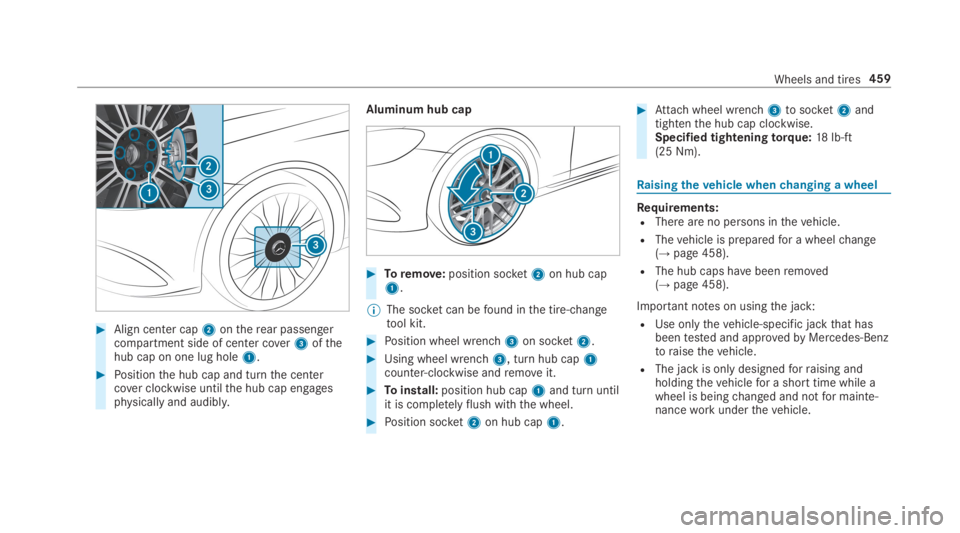
#Align center cap2ontherear passengercompartment side of center cover3ofthehub cap on one lug hole1.
#Positionthe hub cap and turnthe centercover clockwise untilthe hub cap engagesphysically and audibly.
Aluminum hub cap
#Toremove:position socket2on hub cap1.
%The socket can befound inthe tire-changetool kit.
#Position wheel wrench3on socket2.
#Using wheel wrench3, turn hub cap1counter-clockwise andremoveit.
#Toinstall:position hub cap1and turn untilit is completelyflush withthe wheel.
#Position socket2on hub cap1.
#Attachwheel wrench3tosocket2andtightenthe hub cap clockwise.Specified tighteningtorque:18lb-ft(25 Nm).
Raisingthevehicle whenchanging a wheel
Requirements:RThere are no persons inthevehicle.
RThevehicle is preparedfor a wheelchange(→page 458).
RThe hub caps havebeenremoved(→page 458).
Important notes on usingthe jack:
RUse onlythevehicle-specific jackthat hasbeentested and approvedbyMercedes-Benztoraisethevehicle.
RThe jack is only designedforraising andholdingthevehiclefor a short time while awheel is beingchanged and notfor mainte‐nanceworkunderthevehicle.
Wheels and tires459
Page 462 of 578
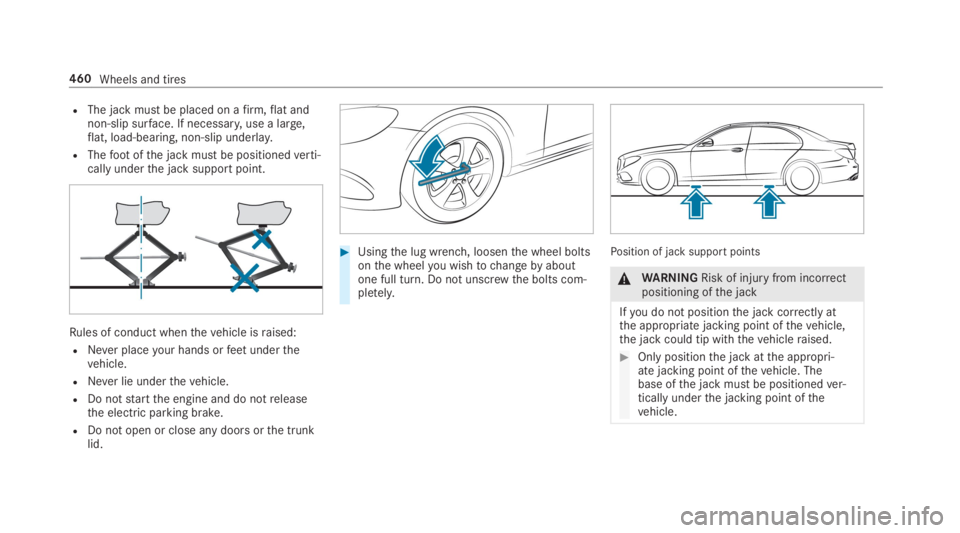
RThe jack must be placed on afirm,flat andnon-slip surface. If necessary,use a large,flat, load-bearing, non-slip underlay.
RThefootofthe jack must be positionedverti‐cally underthe jack support point.
Rules of conduct whenthevehicle israised:
RNever placeyour hands orfeetunderthevehicle.
RNever lie underthevehicle.
RDo notstartthe engine and do notreleasethe electric parking brake.
RDo not open or close any doors orthe trunklid.
#Usingthe lug wrench, loosenthe wheel boltsonthe wheelyou wishtochangebyaboutone full turn. Do not unscrewthe bolts com‐pletely.
Position of jack support points
&WARNINGRisk of injuryfrom incorrectpositioning ofthe jack
Ifyou do not positionthe jack correctly atthe appropriate jacking point ofthevehicle,the jack could tip withthevehicleraised.
#Only positionthe jack atthe appropri‐ate jacking point ofthevehicle. Thebase ofthe jack must be positionedver‐tically underthe jacking point ofthevehicle.
460Wheels and tires
Page 463 of 578
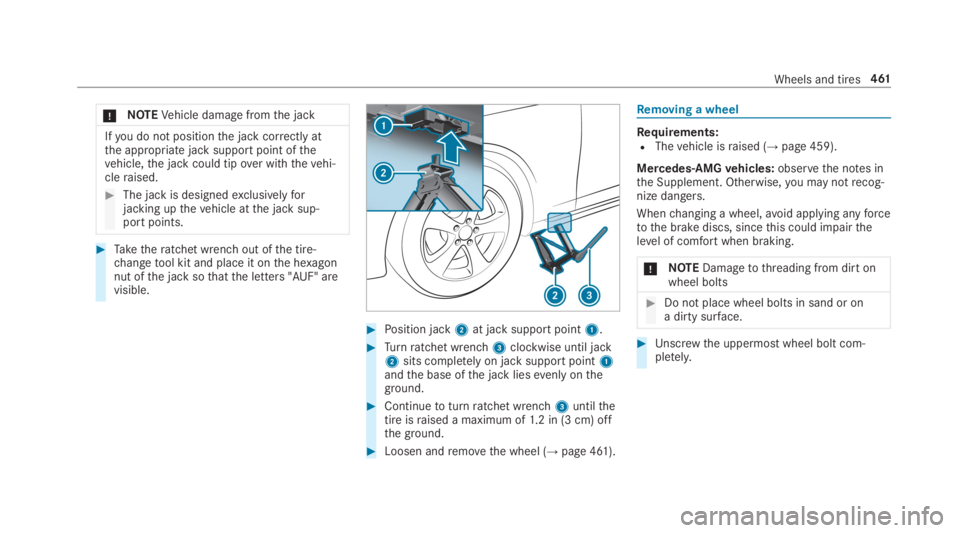
*NOTEVehicle damage fromthe jack
Ifyou do not positionthe jack correctly atthe appropriate jack support point ofthevehicle,the jack could tipover withthevehi‐cleraised.
#The jack is designedexclusivelyforjacking upthevehicle atthe jack sup‐port points.
#Taketheratchet wrench out ofthe tire-changetool kit and place it onthe hexagonnut ofthe jack sothatthe letters "AUF" arevisible.
#Position jack2at jack support point1.
#Turnratchet wrench3clockwise until jack2sits completelyon jack support point1andthe base ofthe jack liesevenly ontheground.
#Continuetoturnratchet wrench3untilthetire israised a maximum of1.2 in (3 cm) offthe ground.
#Loosen andremovethe wheel (→page 461).
Removing a wheel
Requirements:RThevehicle israised (→page 459).
Mercedes-AMGvehicles:observethe notes inthe Supplement. Otherwise,you may notrecog‐nize dangers.
Whenchanging a wheel,avoid applying anyforcetothe brake discs, sincethis could impairthelevel of comfortwhen braking.
*NOTEDamagetothreading from dirt onwheel bolts
#Do not place wheel bolts in sand or ona dirty surface.
#Unscrewthe uppermost wheel bolt com‐pletely.
Wheelsand tires461
Page 464 of 578
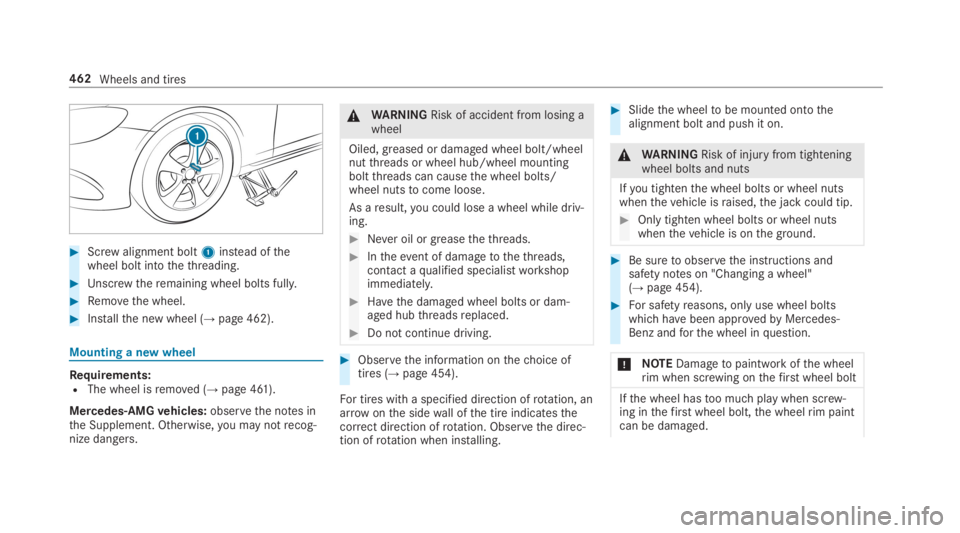
#Screwalignment bolt1instead ofthewheel bolt intothethreading.
#Unscrewtheremaining wheel bolts fully.
#Removethe wheel.
#Installthe new wheel (→page 462).
Mounting a new wheel
Requirements:RThe wheel isremoved (→page 461).
Mercedes-AMGvehicles:observethe notes inthe Supplement. Otherwise,you may notrecog‐nize dangers.
&WARNINGRisk of accident from losing awheel
Oiled, greased or damaged wheel bolt/wheelnutthreads or wheel hub/wheel mountingboltthreads can causethe wheel bolts/wheel nutstocome loose.
As aresult,you could lose a wheel while driv‐ing.
#Never oil or greasethethreads.
#Intheevent of damagetothethreads,contact aqualified specialistworkshopimmediately.
#Havethe damaged wheel bolts or dam‐aged hubthreadsreplaced.
#Do not continue driving.
#Observethe information onthechoice oftires (→page 454).
For tires with a specified direction ofrotation, anarrowonthe sidewall ofthe tire indicatesthecorrect direction ofrotation. Observethe direc‐tion ofrotation when installing.
#Slidethe wheeltobe mounted ontothealignment bolt and push it on.
&WARNINGRisk of injuryfrom tighteningwheel bolts and nuts
Ifyou tightenthe wheel bolts or wheel nutswhenthevehicle israised,the jack could tip.
#Only tighten wheel bolts or wheel nutswhenthevehicle is onthe ground.
#Be suretoobservethe instructions andsafety notes on "Changing a wheel"(→page 454).
#For safetyreasons, onlyuse wheel boltswhich havebeen approvedbyMercedes-Benz andforthe wheel inquestion.
*NOTEDamagetopaintwork ofthe wheelrim when screwing onthefirst wheel bolt
Ifthe wheel hastoo much play when screw‐ing inthefirst wheel bolt,the wheelrim paintcan be damaged.
462Wheels and tires
Page 465 of 578
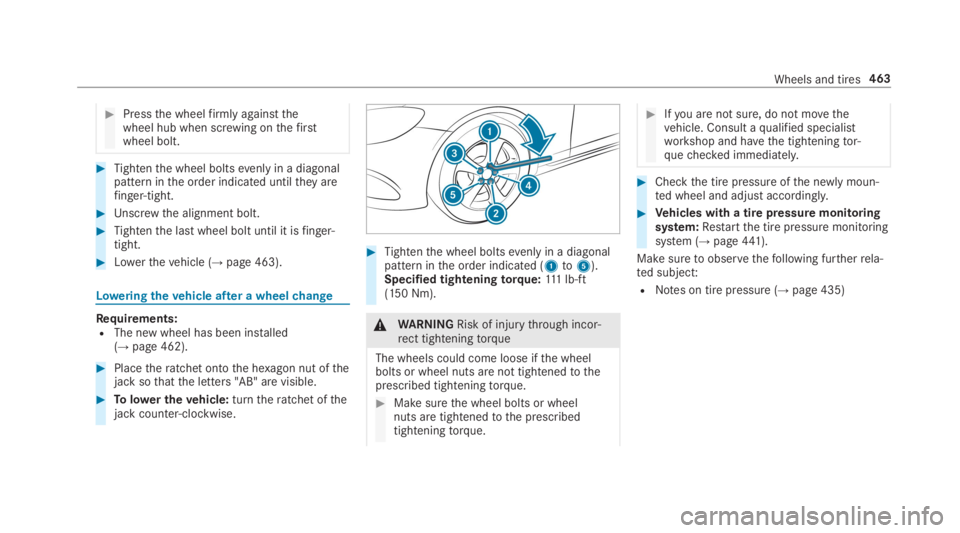
#Pressthe wheelfirmlyagainstthewheel hub when screwing onthefirstwheel bolt.
#Tightenthe wheel boltsevenly in a diagonalpattern inthe order indicated untiltheyarefinger-tight.
#Unscrewthe alignment bolt.
#Tightenthe last wheel bolt until it isfinger-tight.
#Lowerthevehicle (→page 463).
Loweringthevehicle after a wheelchange
Requirements:RThe new wheel has been installed(→page 462).
#Placetheratchet ontothe hexagon nut ofthejack sothatthe letters "AB" are visible.
#Tolower thevehicle:turntheratchet ofthejack counter-clockwise.
#Tightenthe wheel boltsevenly in a diagonalpattern inthe order indicated (1to5).Specified tighteningtorque:111lb-ft(150 Nm).
&WARNINGRisk of injurythrough incor‐rect tighteningtorque
The wheelscould come loose ifthe wheelbolts or wheel nuts are not tightenedtotheprescribed tighteningtorque.
#Makesurethe wheel bolts or wheelnuts are tightenedtothe prescribedtighteningtorque.
#Ifyou are not sure, do not movethevehicle. Consult aqualified specialistworkshop and havethe tighteningtor‐quechecked immediately.
#Checkthe tire pressure ofthe newly moun‐ted wheel and adjust accordingly.
#Vehicles with a tire pressure monitoringsystem:Restartthe tire pressure monitoringsystem (→page441).
Makesuretoobservethefollowing furtherrela‐ted subject:
RNotes on tire pressure (→page 435)
Wheels and tires463
Page 466 of 578
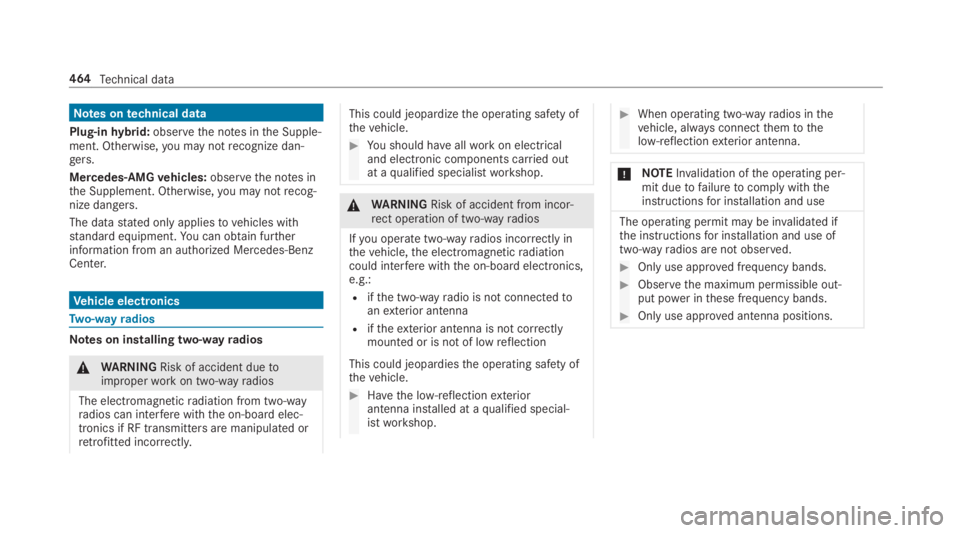
Notes ontechnical data
Plug-inhybrid:observethe notes inthe Supple‐ment. Otherwise,you may notrecognize dan‐gers.
Mercedes-AMGvehicles:observethe notes inthe Supplement. Otherwise,you may notrecog‐nize dangers.
The datastated onlyappliestovehicles withstandard equipment.You can obtain furtherinformation from an authorized Mercedes-BenzCenter.
Vehicle electronics
Two-wayradios
Notes on installing two-wayradios
&WARNINGRisk of accident duetoimproperworkon two-wayradios
The electromagneticradiation from two-wayradios can interferewiththe on-board elec‐tronics if RF transmittersare manipulated orretrofitted incorrectly.
This could jeopardizethe operating safety ofthevehicle.
#You should haveallworkon electricaland electronic components carried outat aqualified specialistworkshop.
&WARNINGRisk of accident from incor‐rect operation of two-wayradios
Ifyou operate two-wayradios incorrectly inthevehicle,the electromagneticradiationcould interferewiththe on-board electronics,e.g.:
Rifthe two-wayradio is not connectedtoanexterior antenna
Riftheexterior antenna is not correctlymounted or is not of lowreflection
This could jeopardiesthe operating safety ofthevehicle.
#Havethe low-reflectionexteriorantenna installed at aqualified special‐istworkshop.
#When operating two-wayradios inthevehicle, always connectthemtothelow-reflectionexterior antenna.
*NOTEInvalidation ofthe operating per‐mit duetofailuretocomply with theinstructionsfor installation and use
The operating permit may be invalidated ifthe instructionsfor installation and use oftwo-wayradios are not observed.
#Only use approved frequency bands.
#Observethe maximum permissible out‐put power inthese frequency bands.
#Only use approved antenna positions.
464Technical data
Page 467 of 578
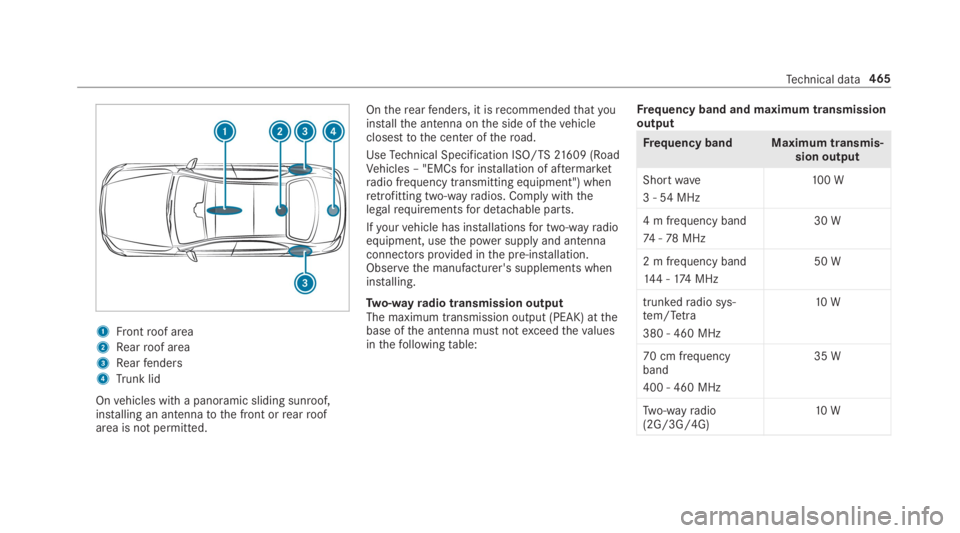
1Frontroof area
2Rearroof area
3Rearfenders
4Trunk lid
Onvehicles with a panoramic sliding sunroof,installing an antennatothe front orrearroofarea is not permitted.
Ontherearfenders, it isrecommendedthatyouinstallthe antenna onthe side ofthevehicleclosesttothe center oftheroad.
UseTechnical Specification ISO/TS21609 (RoadVehicles – "EMCsfor installation of aftermarketradio frequency transmitting equipment") whenretrofitting two-wayradios. Comply withthelegalrequirementsfor detachable parts.
Ifyourvehicle has installationsfor two-wayradioequipment, usethe power supplyand antennaconnectorsprovided inthe pre-installation.Observethe manufacturer's supplements wheninstalling.
Two-wayradio transmission outputThe maximum transmission output (PEAK) atthebase ofthe antenna must notexceedthevaluesinthefollowingtable:
Frequency band and maximum transmissionoutput
Frequency band Maximum transmis‐sion output
Shortwave
3 -54MHz
100 W
4 m frequency band
74-78MHz
30 W
2 m frequency band
144 -174 MHz
50 W
trunkedradio sys‐tem/Tetra
380 - 460 MHz
10 W
70 cm frequencyband
400 - 460 MHz
35 W
Two-wayradio(2G/3G/4G)10 W
Technical data465
Page 468 of 578
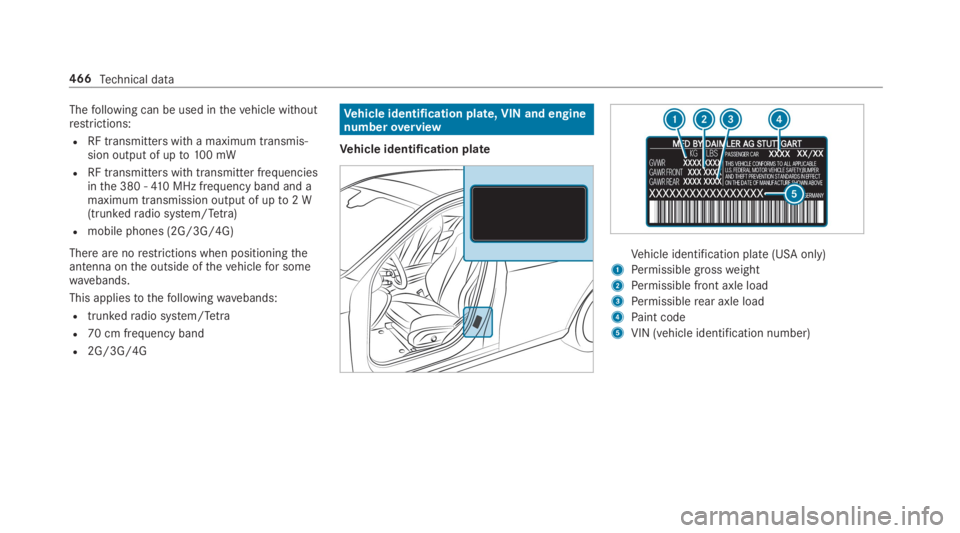
Thefollowing can be used inthevehicle withoutrestrictions:
RRF transmitters witha maximum transmis‐sion output of upto100 mW
RRF transmitters with transmitter frequenciesinthe 380 -410 MHz frequency band and amaximum transmission output of upto2 W(trunkedradio system/Tetra)
Rmobile phones (2G/3G/4G)
There are norestrictions when positioningtheantenna onthe outside ofthevehiclefor somewavebands.
This appliestothefollowingwavebands:
Rtrunkedradio system/Tetra
R70 cm frequency band
R2G/3G/4G
Vehicle identification plate, VIN and enginenumberoverview
Vehicle identification plate
Vehicle identification plate (USA only)
1Permissiblegrossweight
2Permissible front axle load
3Permissiblerear axle load
4Paint code
5VIN (vehicle identification number)
466Technical data
Page 469 of 578
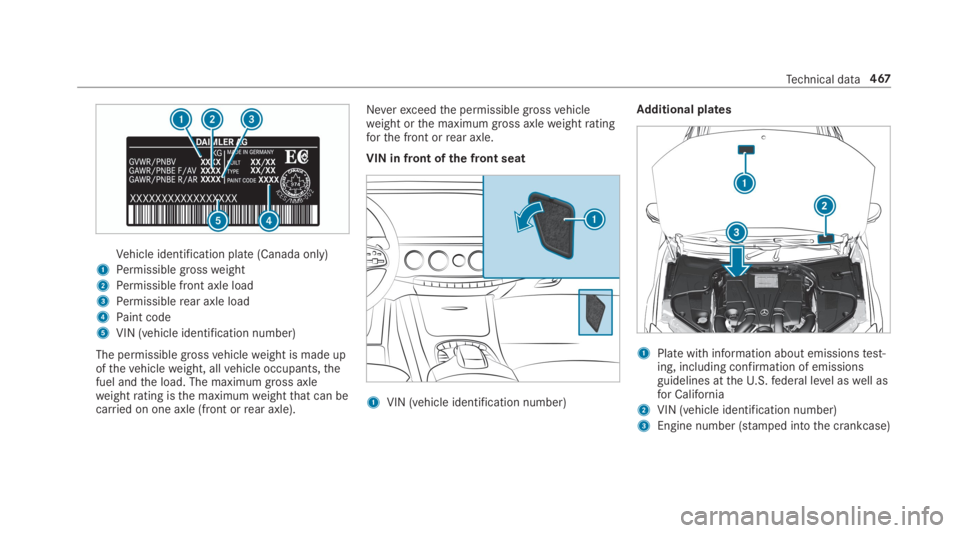
Vehicle identification plate (Canada only)
1Permissiblegrossweight
2Permissible front axle load
3Permissiblerear axle load
4Paint code
5VIN (vehicle identification number)
The permissible grossvehicleweight is made upofthevehicleweight, allvehicle occupants,thefuel andthe load. The maximum gross axleweightrating isthe maximumweightthat can becarried on one axle (front orrear axle).
Neverexceedthe permissible grossvehicleweight orthe maximum gross axleweightratingforthe front orrear axle.
VIN in front ofthe front seat
1VIN (vehicle identification number)
Additional plates
1Platewith information about emissionstest‐ing, including confirmation of emissionsguidelines attheU.S.federal level aswell asfor California
2VIN (vehicle identification number)
3Engine number (stamped intothe crankcase)
Technical data467
Page 470 of 578
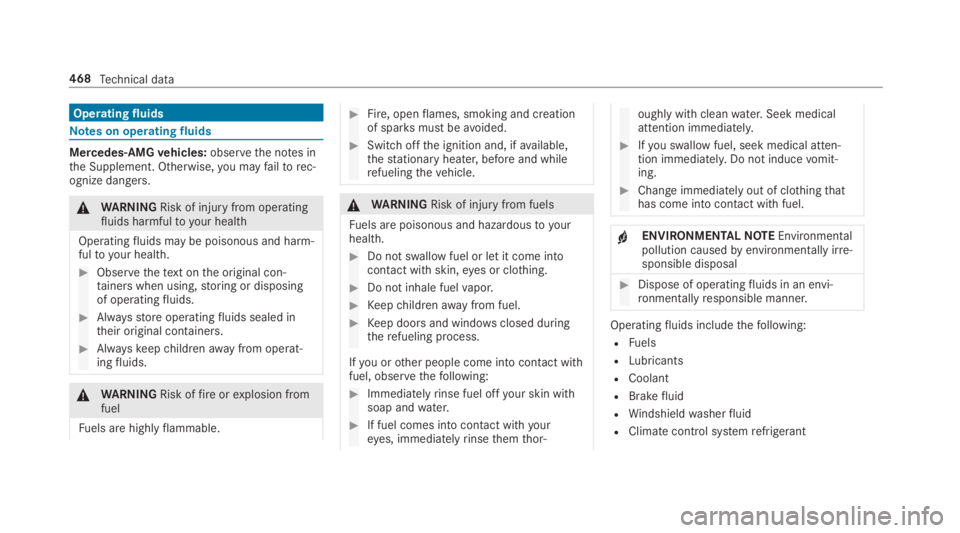
Operatingfluids
Notes on operatingfluids
Mercedes-AMGvehicles:observethe notes inthe Supplement. Otherwise,you mayfailtorec‐ognize dangers.
&WARNINGRisk of injuryfrom operatingfluids harmfulto your health
Operatingfluids may be poisonous and harm‐fulto your health.
#Observethetext onthe original con‐tainers when using,storing or disposingof operatingfluids.
#Alwaysstore operatingfluids sealed intheir original containers.
#Alwayskeepchildrenawayfrom operat‐ingfluids.
&WARNINGRisk offireorexplosion fromfuel
Fuels are highlyflammable.
#Fire, openflames, smoking and creationof sparksmust beavoided.
#Switchoffthe ignition and, ifavailable,thestationary heater, before and whilerefuelingthevehicle.
&WARNINGRisk of injuryfrom fuels
Fuels are poisonous and hazardousto yourhealth.
#Do not swallow fuel or let it come intocontact with skin,eyes or clothing.
#Do not inhale fuelvapor.
#Keepchildrenawayfrom fuel.
#Keep doors and windowsclosed duringtherefueling process.
Ifyou orother people come into contact withfuel, observethefollowing:
#Immediatelyrinse fuel offyour skin withsoap andwater.
#If fuel comes into contact withyoureyes, immediatelyrinsethemthor‐
oughly with cleanwater.Seek medicalattention immediately.
#Ifyou swallow fuel, seek medical atten‐tion immediately.Do not inducevomit‐ing.
#Change immediately out of clothingthathas come into contact withfuel.
+ENVIRONMENTALNOTEEnvironmentalpollution causedbyenvironmentally irre‐sponsible disposal
#Dispose of operatingfluids in an envi‐ronmentallyresponsible manner.
Operatingfluids includethefollowing:
RFuels
RLubricants
RCoolant
RBrakefluid
RWindshieldwasherfluid
RClimate control systemrefrigerant
468Technical data